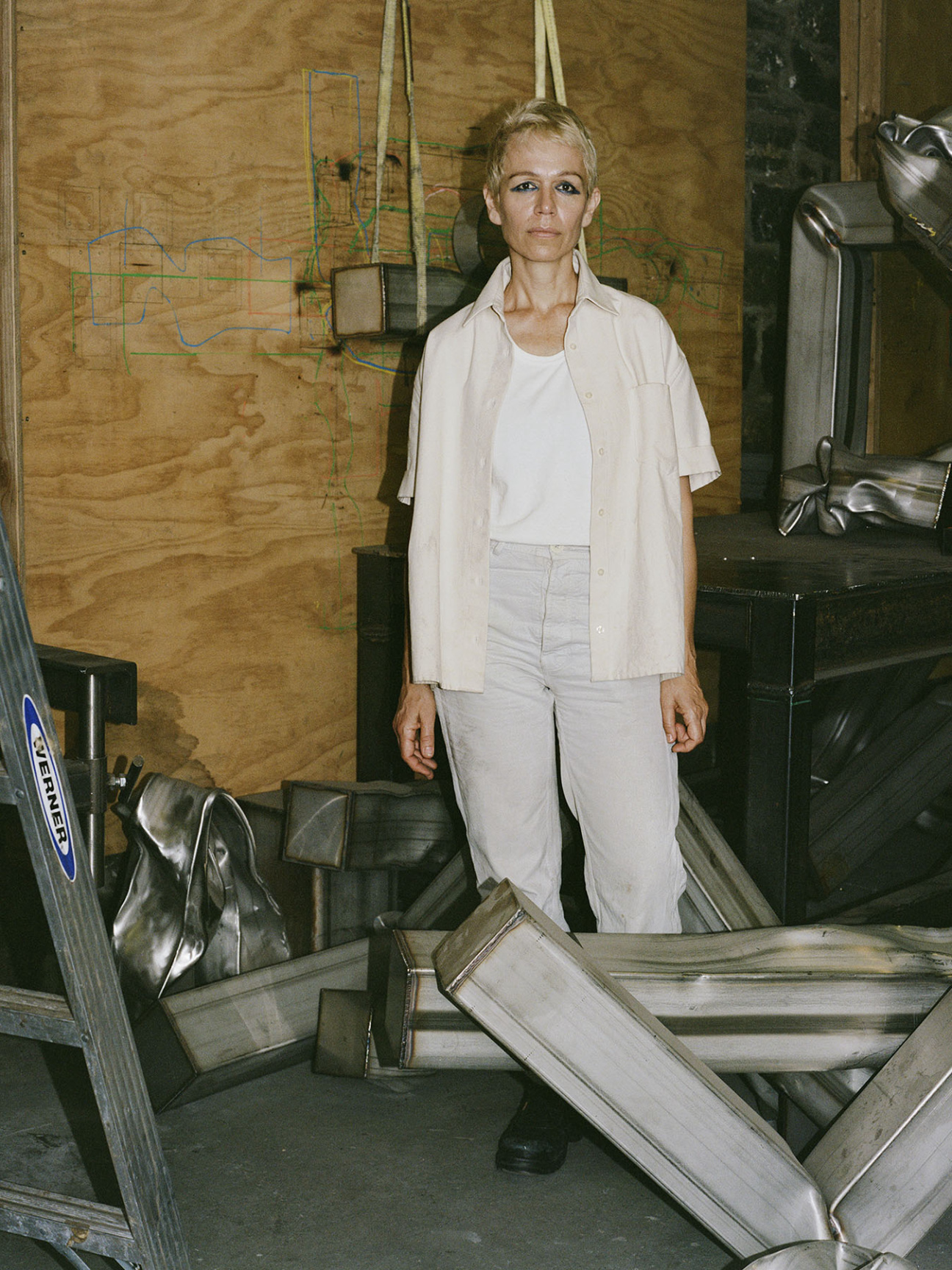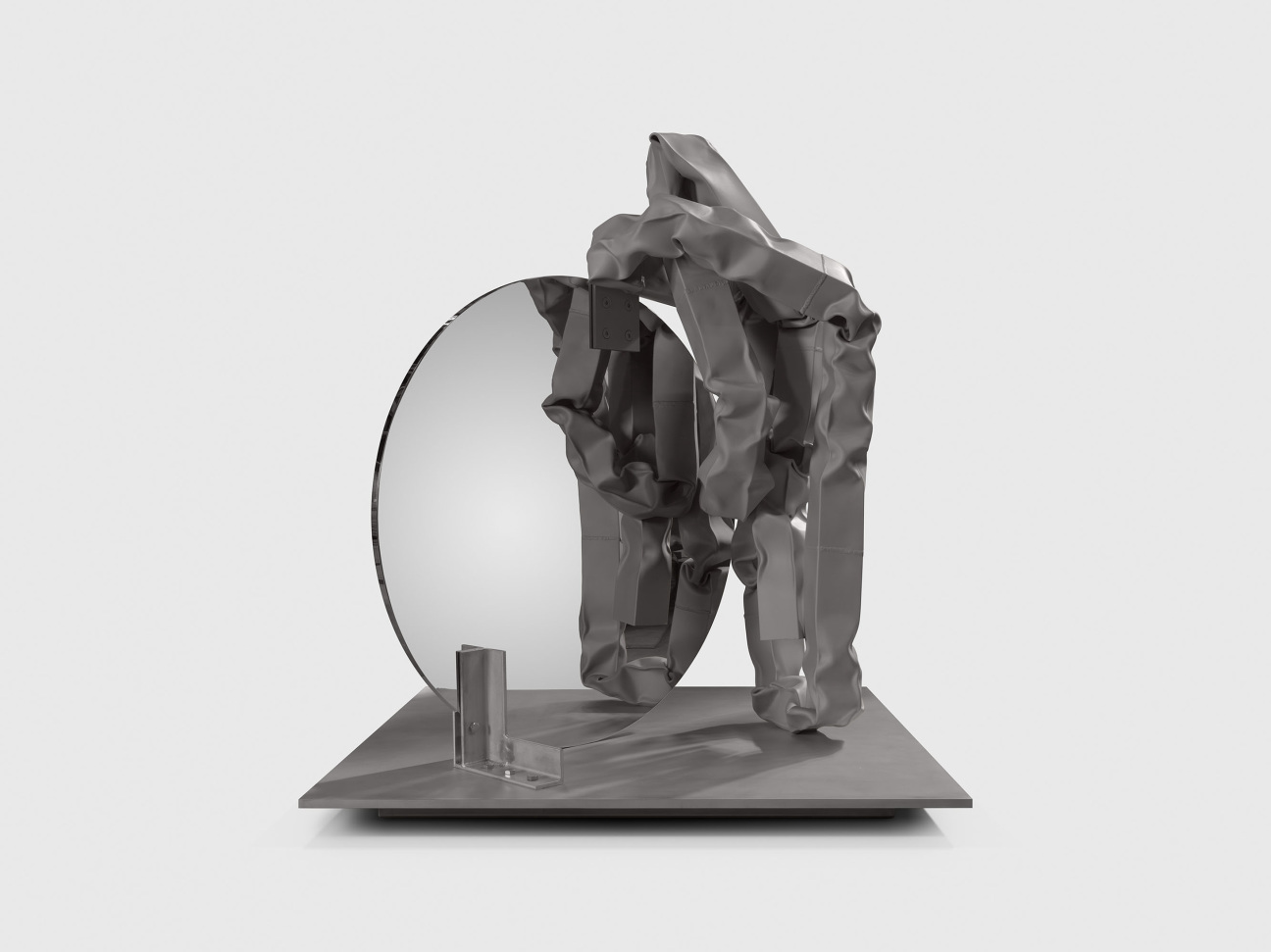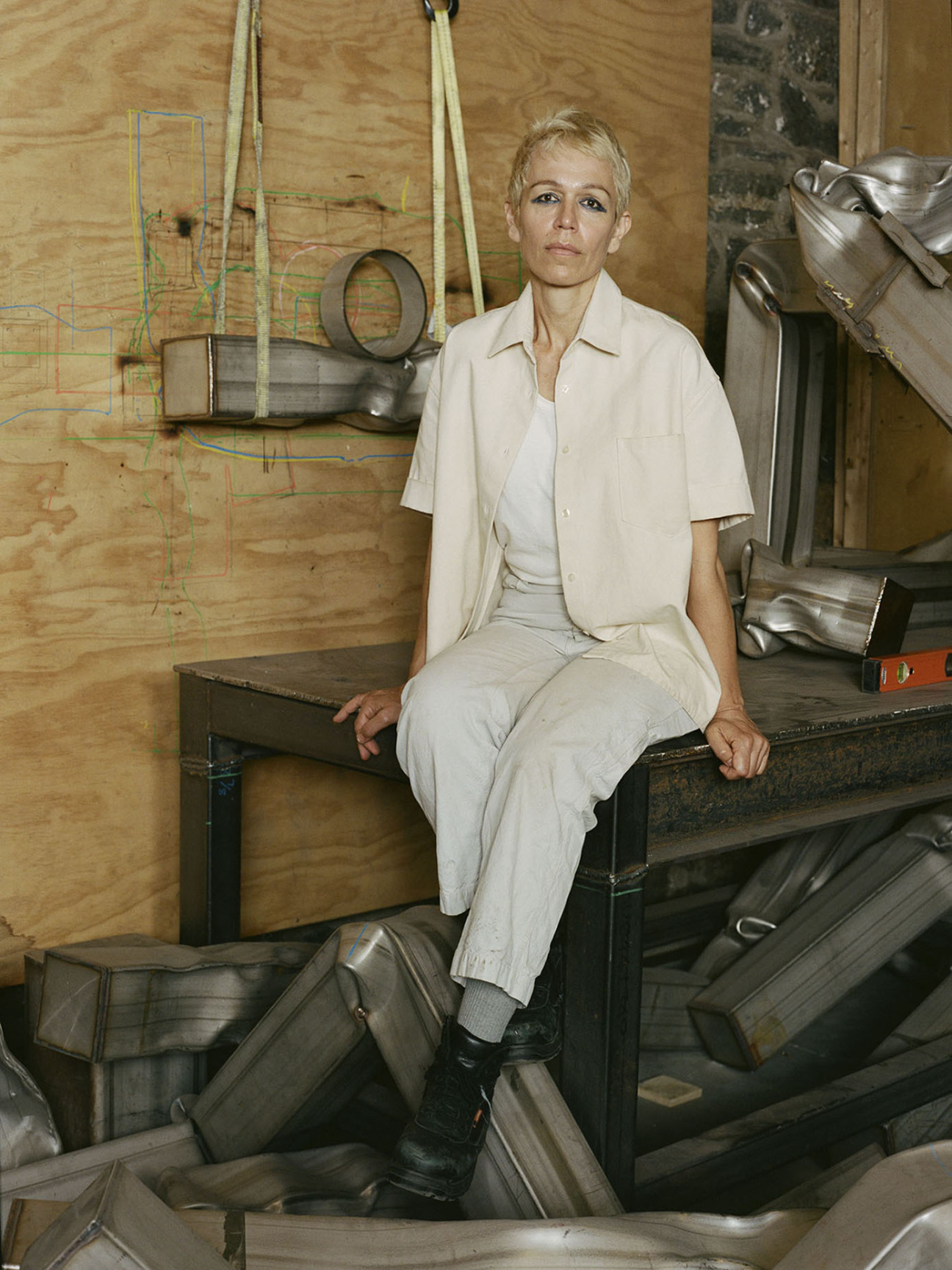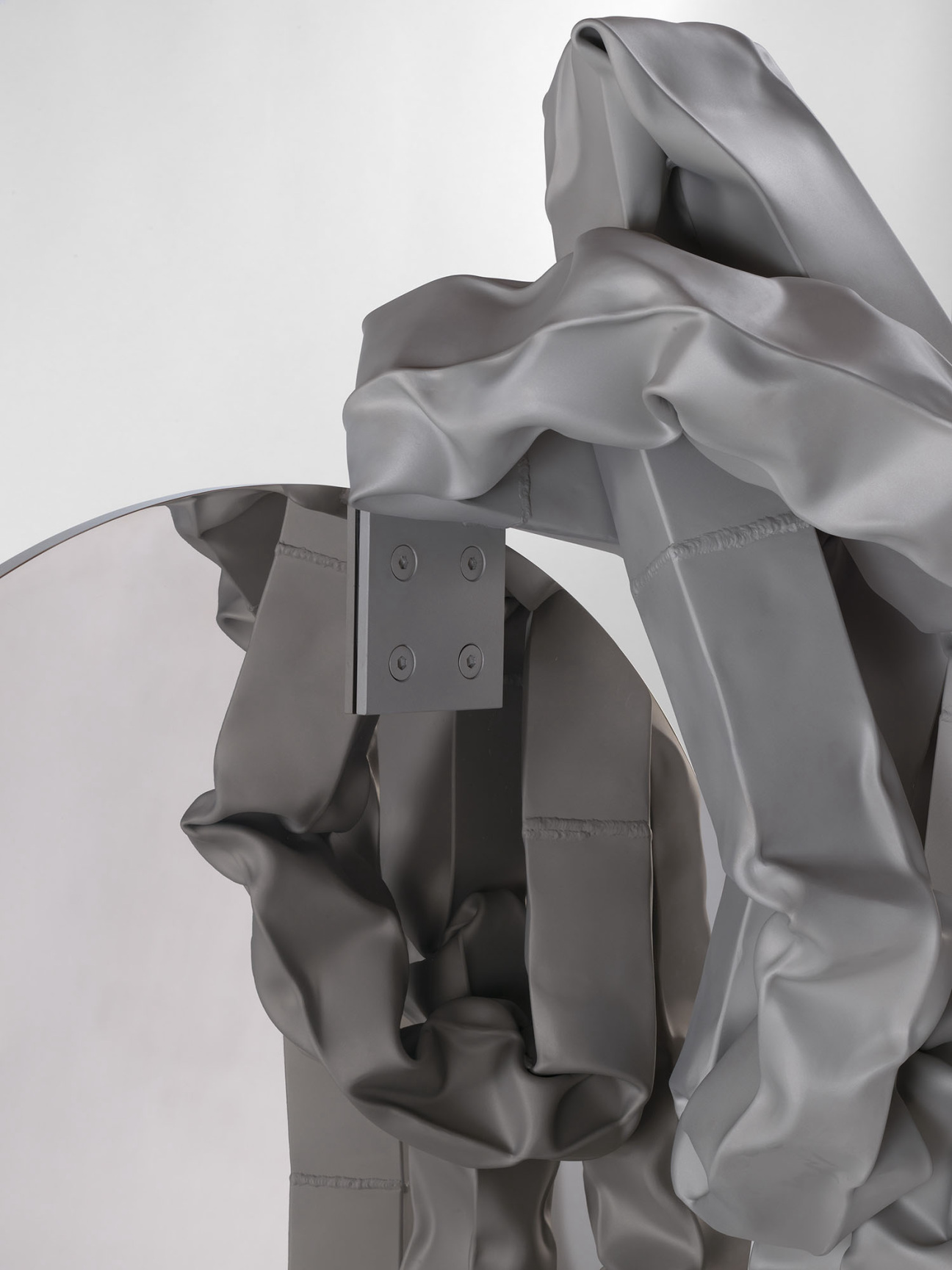
“Hardware Romance is a germinal work,” Carol Bove told me this past October, “not a seminal work in the masculinist sense, but a germinal one.” Created while she was working on “The séances aren’t helping,” her monumental four-part commission for the Metropolitan Museum of Art’s façade, Hardware Romance is a meditation on the full spectrum of stainless steel’s polarity, conceived for interior—perhaps even domestic—space.
The piece distills fascinations that have marked Bove’s oeuvre since the 2000s: the relative strength and delicacy of a given material, the history of countercultural and mystical thought, a certain emphasis on relationships—between objects and materials, and between materials and their history—condensed into a single, succinct statement.
The sculpture consists of one of Bove’s signature “polka dot” discs polished to mirror-like perfection and embraced by an almost-humanoid form rendered in crumpled stainless steel tubing. It playfully invokes the myth of Narcissus, turning the normally unreflective surface of stainless steel—with its utterly utilitarian and even warlike sobriety—into the shining field through which the material seeks to know itself. It’s a koan about love and self-knowledge and the limits thereof.
“Hardware Romance” is also the Swiss-American sculptor’s first exhibition with Gagosian, following her much-watched departure from David Zwirner. It arrives in a wave of expansive energy following the October opening of “Fragments of a Faith Forgotten,” an exhibition of the late Harry Smith at the Whitney, which Bove co-curated and designed, not to mention her sold-out works at Paris+. I caught up with the artist by phone in Switzerland last month.

Ariana Reines: So Hardware Romance was made contiguously with the work you made for the Met façade commission in 2021?
Carol Bove: It happened at the same time that I was doing the works for the Met. I was able to really take my time with it. There was no deadline; I was just doing it because I needed to see this thing. The disc [in the work] has a stainless steel mirror finish, a process that maybe six places in the world can do perfectly. It’s really difficult work, and most of them won’t even take the job because it’s such a bitch. The result is that it looks digital.
Reines: That’s one of the things that I love about your work. As an ignoramus viewer, my eye is trained to identify certain surfaces or industrially produced effects that I’m used to, but your objects have this aura that goes completely against that cognitive preparation. That’s where the romance and the mystery emerge in what you’re doing.
Bove: From the beginning, I have been determined to not have my personality in the work. I don’t want it to be crowded with the quirks of my particular being, so that there’s space for you to fill it with something. It is what you bring to it.
Reines: The stainless steel in “Hardware Romance” and the aluminum in the Met commission remind me of my romantic feelings for certain 20th-century aesthetic and design norms. I found myself thinking of mirrors that you can’t really see your reflection in—like in a prison bathroom—those surfaces where you’re looking for your reflection and it’s there, but occluded by some industrial process.
That’s why I find your work very dance-like. It’s like dancing with a partner—you’re creating conditions so that improvisation is possible. At the same time, your work is so deeply considered and philosophized. How do the empirical parts of your process interact with the spontaneity of it? Do you get lightning inspirations?

Bove: I’m really interested in other people—and seduction. I think a lot about the viewer. I imagine a viewer who is somewhat defiant, and who has to be disarmed in order to get close. It’s through phenomenology that you are addressed as a viewer and then can find your own home in the work.
A kind of difficult assault comes later, because the way the works come together is the result of all the worst parts of our society, including war. The process of making these things is horrible, the extraction of these metals from the earth is like the kind of midwifery where you cut the baby out. My work has these really dark shadows, but it’s not pretending that they aren’t there.
Reines: There’s a fascinating, dignified respect for the stranger in play here—or else the work doesn’t function. I can feel an ethics in that. Can I ask you about your spiritual practice?
Bove: Sure. I sense that you deal with this too—you want to communicate, but your audience is skeptical about spirituality. You can lose credibility if you say the wrong thing, and you already have the liability of being a woman. I’m really into lojong slogans. It’s a medieval Tibetan thing; there are 59 slogans for awakening bodhicitta and strengthening it. Your mind is making thoughts all the time; it’s crazy how many billions of repetitive, useless thoughts you have during a day, a month, or a lifetime. To have something you can return to that awakens the dharma, I find that helpful.
Reines: I think of my work in terms of uselessness. It’s an ethos: Nobody needs what I’m writing. I remember Oscar Wilde saying, “Art is totally useless,” or whatever. I was just like, “That’s hot, that’s the coolest thing I’ve ever heard.”

Bove: It goes so against the grain. It contains a paradox: People need uselessness, so then it serves a purpose. That is a way to depolarize a power dynamic—through a field of meaning that doesn’t have a point.
Reines: That’s why art is such a relief. It allows the parts of you that are deadened by that dynamic to reawaken. I’m thinking about what you said about midwifery and violence in the materials you work with. Before alchemy and chemistry split off from each other in the 17th century, when people were just experimenting with how substances interacted, there was this idea that you ought not to just pour acid on something to impose change, you should work with the material.
In your work, you take these big industrial tubes and make them bend and dance—you have to do things to them to make them do that. Do you think about gentleness when you’re working with these materials, or is it more erotic and S&M than that?
Bove: Making large-scale and steel works happens really, really slowly. There is a kind of gentleness in working with the steel. There are no sudden moves. The way that the compression works, it’s almost like an embrace. That’s how the softness is drawn out of the material. Steel is very hard, but under certain conditions it’s liquid—so actually, it’s just relative, and one factor of that is time. This has been a current in my thinking for a while, but now I have a more deliberate practice of thinking about scales of time. If I can expand my sense of time to contain 500 years, then making something slowly seems to happen really fast. You can kind of walk around and live according to your own sense of time.
Reines: One of the things about your practice is the way you work with proportion and relativity in a very specific way. Which is to say, What is gentle? Steel. You contrast heavy or delicate materials to stimulate the mind towards that sort of contemplation about strength. I could say your work is about strength—a boring thing to say.
Bove: It’s not boring, it’s taboo.
“Hardware Romance” is on view through January 27, 2024 at Gagosian in New York.










 in your life?
in your life?

